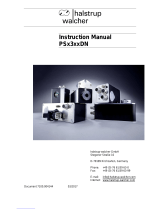
Introduction
Copyrights, Limitation of Liability
and Revision Rights
This publication contains information proprietary to
Danfoss A/S. By accepting and using this manual the
user agrees that the information contained herein will
be used solely for operating equipment of Danfoss A/
S or equipment from other vendors provided that such
equipment is intended for communication with Dan-
foss equipment over a PROFIBUS serial communica-
tion link. This publication is protected under the
Copyright laws of Denmark and most other countries.
Danfoss A/S does not warrant that a software program
produced according to the guidelines provided in this
manual will function properly in every physical, hard-
ware or software environment.
Although Danfoss A/S has tested and reviewed the
documentation within this manual, Danfoss A/S makes
no warranty or representation, either express or im-
plied, with respect to this documentation, including its
quality, performance, or fitness for a particular pur-
pose.
In no event shall Danfoss A/S be liable for direct, indi-
rect, special, incidental, or consequential damages
arising out of the use, or the inability to use information
contained in this manual, even if advised of the possi-
bility of such damages. In particular, Danfoss A/S is
not responsible for any costs including but not limited
to those incurred as a result of lost profits or revenue,
loss or damage of equipment, loss of computer pro-
grams, loss of data, the costs to substitute these, or
any claims by third parties.
Danfoss A/S reserves the right to revise this publica-
tion at any time and to make changes in its contents
without prior notice or any obligation to notify previous
users of such revisions or changes.
NOTE
Note regarding Profibus FMS
If you want to run FMS you have to pur-
chase as follows:
For VLT 5000:
175Z3722 (uncoated)
175Z3723 (coated)
For VLT 6000 HVAC:
175Z4207 (uncoated)
175Z4208 (coated)
It is NOT possible to run FMS from a VLT
5000 FLUX or a VLT 8000 AQUA.
This manual does not deal with Profibus
FMS, only with Profibus DP. However, in
the event that the communication is to be
built up through Profibus FMS, you should
request the description MG.10.E3.yy
”Profibus Product Manual“ which also
contains a description of the Profibus FMS
functions of the Profibus option card.
About this manual
This manual is intended as both an instruction manual
and a reference guide. It only broaches the basics of
the PROFIBUS DP protocol, and only when it is nec-
essary to provide a sufficient understanding of the
PROFIDRIVE implementation of the PROFIBUS pro-
file for frequency converters (version 2, PNO) and of
the PROFIBUS option card for the series VLT 5000/
VLT 5000 Flux/VLT 6000 HVAC/VLT 8000 AQUA by
DANFOSS.
Unit
Software version
FCD 300 Ver. 1.30
FCM 300 -
VLT 2800 Ver. 2.64
VLT 5000 Ver. 3.62
VLT 6000 HVAC Ver. 2.41
VLT 8000 AQUA Ver. 1.12
The above table shows from which software versions
Profibus DP V1 is supported. The software version can
be read-out in parameter 624 Software versions.
This manual gives detailed information of the DP V0
features supported, sufficient for most programming
and maintenance activities. The DP V1 however is
briefly described. For programming purposes the Pro-
fibus DP V1 Design Guide order number MG.90.EX.YY
(X is the version number, and YY the language code)
might be necessary.
It is suggested that readers who are not completely
familiar with PROFIBUS DP or the profile for frequency
converters review the relevant literature on these sub-
jects.
Even if you are an experienced PROFIBUS program-
mer, we suggest that you read this manual in its en-
VLT
®
5000/ 5000 FLUX/ 6000 HVAC/ 8000 AQUA PROFIBUS
MG.90.G1.22 - VLT is a registered Danfoss trademark 3
Introduction





















